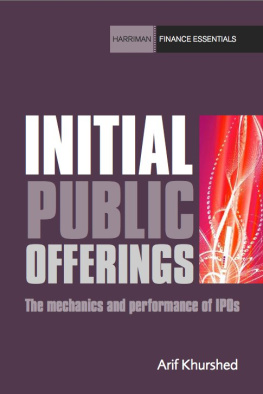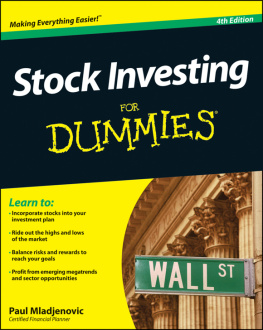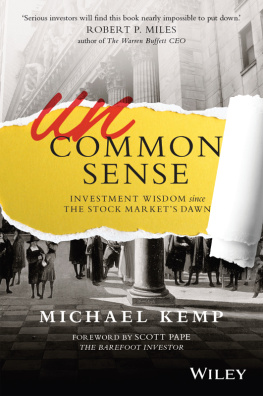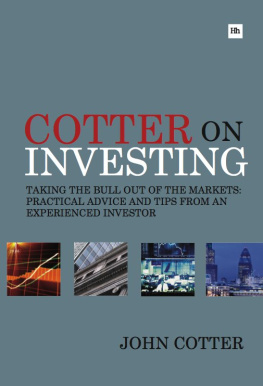Publishing details
HARRIMAN HOUSE LTD
3A Penns Road
Petersfield
Hampshire
GU32 2EW
GREAT BRITAIN
Tel: +44 (0)1730 233870
Fax: +44 (0)1730 233880
Email: enquiries@harriman-house.com
Website: www.harriman-house.com
First published in Great Britain in 2011
Copyright Harriman House Ltd
The right of Arif Khurshed to be identified as Author has been asserted in accordance with the Copyright, Design and Patents Act 1988.
ISBN: 978-0-85719-137-3
British Library Cataloguing in Publication Data
A CIP catalogue record for this book can be obtained from the British Library.
All rights reserved; no part of this publication may be reproduced, stored in a retrieval system, or transmitted in any form or by any means, electronic, mechanical, photocopying, recording, or otherwise without the prior written permission of the Publisher. This book may not be lent, resold, hired out or otherwise disposed of by way of trade in any form of binding or cover other than that in which it is published without the prior written consent of the Publisher.
No responsibility for loss occasioned to any person or corporate body acting or refraining to act as a result of reading material in this book can be accepted by the Publisher or by the Author.
Acknowledgements
I would like to thank Liz Hardy of London Stock Exchange (LSE) for allowing me to cite and reproduce some material from a survey conducted by the LSE. Thank you to Jay Ritter and Silvio Vismara for their comments and input on an earlier version of the text. I also thank my family for their patience and support especially during periods of writers block. I dedicate this book to my wife and two children.
About the Author
Arif Khurshed completed his PhD from ICMA Centre, University of Reading, in the year 1999 and joined Manchester Business School (MBS), University of Manchester, as a post doctoral researcher. He is a senior lecturer in the Division of Accounting & Finance, MBS.
Arif has taught corporate finance for more than ten years and has been an active researcher in the field of initial public offerings (IPOs), institutional investments and corporate governance. He has published his research in several finance journals and has contributed many book chapters. His research has been covered by the Investors Chronicle, the UK press (TheTimes) and the Thai press (TheNation). Arif has been an external consultant to the UK stock market regulator, the Financial Services Authority (FSA) and to the British Venture Capital Association. Initial Public Offerings is his first book.
Preface
What this book covers
This book is about one of the most attractive areas of investment, Initial Public Offerings (IPOs), commonly referred to as new issues. Reducing an IPO to its very basics, it refers to the occasion when a company issues common stock or shares to the public for the first time. The IPO process is also known as going public, flotation and listing, and throughout this book I use these terms interchangeably.
IPOs have considerable appeal since they allow investors to buy shares in exciting new companies as they make their debut on the stock exchange. In addition, there is the lure of making potentially high returns in a relatively short period of time, as quite often on the first day of trading the share price of these companies closes much higher than the price at which the shares were offered to investors in the IPO.
The main purpose of the book is to provide information on the mechanics and performance of IPOs. Readers will find information on some fundamental questions related to investment in IPO markets, including the different methods of flotation, how IPOs are priced, and the performance of IPOs in the short and long term. The book also provides some information related to investing in the IPO market, including where to find information and how an IPO prospectus is structured.
Who this book is for
This book is for investors, academics and students who want to find out more about how IPOs are arranged and their historic performance. Directors of companies planning an IPO will also find this book helpful.
How this book is structured
This book is organised into the following chapters:
- An Introduction to IPOs: This chapter covers some basic information on going public such as the life cycle of companies, and why and when companies go public. It also discusses how companies prepare for an IPO.
- A History of IPOs: This chapter begins with a discussion of the regulatory and administrative history of UK IPOs at the London Stock Exchange (LSE). A discussion of share trading on LSE follows. The third section of the chapter provides a brief history of IPOs in the UK since 1945. In the last part of the chapter I discuss some high profile UK and international IPOs.
- Mechanics of IPOs: This chapter looks at the dynamics of an IPO, such as the different methods by which a firm can do an IPO on the LSE and their implications for potential investors. Information is included on how IPOs are priced, how to apply for shares and how share allocations are made in practice. There is also a look at when shares are received by investors and when can they be traded.
- The Performance and Survival of IPOs: This chapter looks at what happens once a company successfully lists on the stock market. When investors buy shares in an IPO firm, they expect healthy profits from their investment. Are their profits really healthy? What happens if the investors decide not to sell their shares in the immediate after-market but to hold on to their investments for a longer period of time? Will the IPO firm survive long enough to provide a good return on investment? Questions like these are answered in this chapter using historic and current data on LSE IPOs.
- Investing in IPOs: This chapter looks at where to find information on firms planning an IPO, what the IPO prospectus says about the quality of the firm, and what factors identify good or bad IPO investments.
Chapter 1: An Introduction to IPOs
In this chapter I start with a discussion of the life cycle of companies and how some of them move towards an IPO. The next section discusses why companies may decide to conduct an IPO and the potential disadvantages of such a decision. A discussion of how companies prepare for an IPO follows.
1.1 The life cycle of companies
Businesses in the private sector are started either as unincorporated or incorporated concerns. Unincorporated businesses fall into two types depending on whether there is a single owner (sole trader) or several owners (partnership). With an unincorporated business there is no legal distinction between the business and its owner(s).
Incorporated businesses have a separate legal identity from their owners. Of these, the commonest form are companies limited by shares. They can be private or public limited companies. Private limited companies can only sell their shares or debentures privately but public limited companies (PLCs) can raise capital from the public at large through an IPO.
Both the unincorporated and incorporated businesses are initially funded by the founder owners and as these firms grow they need more capital. The owners may first turn to their friends and family when they need additional funds. Later they may borrow from a bank either as a fixed-term loan or through an overdraft facility. When such sources are exhausted the firms may turn towards private equity providers such as business angels and venture capitalists (VCs).










